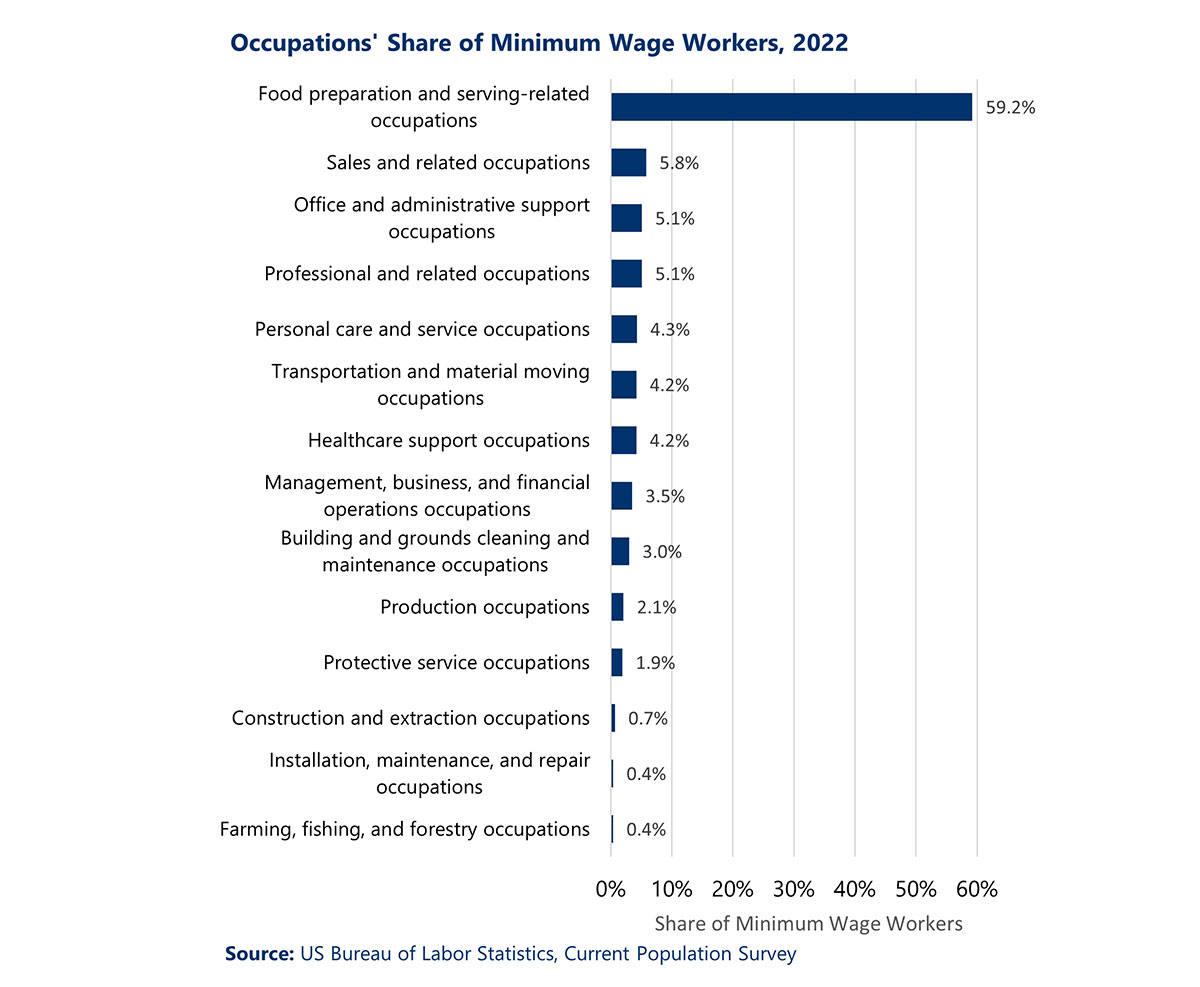- Navigator
- Featured Indicator
- Industry Analytics and Strategy
 The US Bureau of Labor Statistics recently released a report on minimum wage workers that shows that the number of hourly workers paid at or below the prevailing federal minimum wage has declined 85% since 1979, shrinking from a high of 7.8 million workers in 1981 to just 1 million workers in 2022.
The US Bureau of Labor Statistics recently released a report on minimum wage workers that shows that the number of hourly workers paid at or below the prevailing federal minimum wage has declined 85% since 1979, shrinking from a high of 7.8 million workers in 1981 to just 1 million workers in 2022.
This occurred despite a 52% increase in hourly workers in the US, and a 150% increase in the federal minimum wage (which would also increase the number of individuals working at or below the minimum wage).
In 1979, 13.4% of all hourly workers earned minimum wage or less. As of 2022, the share had shrunk to just 1.3% of hourly workers.
Other key takeaways from the report include:
- 56.7% of minimum wage workers in 2022 were young (aged 16–29); most were still in high school or college or recently graduated, and likely had few skills.
- 3.4% of 16- to 19-year-olds working for hourly pay earned minimum wage or less, as did 2.7% of 20- to 24-year-olds and 1.3% of 25- to 29-year-olds.
- Women are disproportionately represented among minimum wage workers. Although men and women represented nearly equal shares of total hourly workers (50.1% vs. 49.9%, respectively) in 2022, men made up just 32.1% of minimum wage workers while women represented 67.9%. This is not significantly different from the shares in 1979, but the rates have fluctuated over the past 43 years.
- Female hourly workers are more likely to earn minimum wage than male workers. In 2022, 1.8% of female hourly workers were paid at or below minimum wage but 0.8% of male hourly workers were.
- Black or African American workers are overrepresented among minimum wage workers. White people represented 75.4% of all hourly workers and 72.6% of minimum wage workers. Asians represented 5.2% of hourly workers and 5% of minimum wage workers. Hispanics or Latinos represented 22.9% of hourly workers and 17.7% of minimum wage workers. However, Black or African American people represented 14.9% of hourly workers but 17.5% of minimum wage workers. (Shares do not add up to 100% because not all racial groups are shown and Hispanics or Latinos can be of any race.)
- A greater share of Black or African American hourly workers earn minimum wage than do other racial or ethnic groups. The data shows that 1.5% of Black or African American hourly workers were paid at or below the minimum wage, compared with 1.3% of White hourly workers, 1.3% of Asians, and 1% of Hispanics or Latinos.

- Over one-third (36%) of minimum wage workers in 2022 were high school graduates with no college education. Another 28.1% of minimum wage workers attended some college (but did not earn a degree) and 15.5% had at least a bachelor’s degree.
- Nearly two-thirds, 66.5%, of minimum wage workers are single (never married). Nearly two-thirds of those (42.9%) are 16–24 years old.
- The states with the highest shares of hourly workers paid at or below minimum wage in 2022 were Louisiana (2.8%), the District of Columbia (2.7%), Mississippi (2.5%), Rhode Island (2.5%), and North Carolina (2.3%). Connecticut (0.1%), Hawaii (0.3%), Nevada (0.4%), and Oregon (0.4%) all had minimum wage shares below 0.5% of hourly workers.
- Not too surprisingly, Food Preparation and Serving-Related occupations account for 59.2% of minimum wage workers, although they represent only 8.8% of all hourly workers. This is likely driven by restaurant wait staff, who are generally paid below minimum wages in lieu of income from tips.

The data shows that most minimum wage workers are young, single, and without a college degree. These workers are just beginning their professional lives, possibly still in school or college, and these jobs likely do not represent long-term career choices. Gaining in-demand skills through education and training is one of the best ways to increase earnings.
The US Congress has increased the federal minimum wage only sporadically over the past 85 years, with the present $7.25/hour rate set in 2009. If the original minimum wage of 25¢/hour set in October 1938 had grown with inflation (as measured by the Consumer Price Index), it would be at $5.37/hour today. However, when Congress does raise the minimum wage, most of the time it is by much more than the amount of inflation since the last increase. Therefore, if the $2.90/hour minimum wage in 1979 had kept pace with inflation, it would be at $11.69/hour today. And if our current minimum wage had increased with inflation since it was set 14 years ago, it would be at $10.24/hour today.
Data in this report were compiled from the Current Population Survey (CPS), a monthly household survey conducted by the US Census Bureau. The CPS data covers only “wage and salary” workers and excludes the self-employed. Minimum wage numbers are calculated only for workers paid an hourly wage due to data quality concerns around calculating an equivalent hourly rate for salaried employees.
Camoin Associates is a national leader in using research and data analysis to help communities and organizations understand where they are now and develop actionable, equitable goals designed to get them where they want to be. Learn more about our services.





